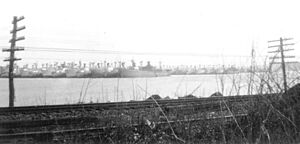Hudson River Reserve Fleet facts for kids
The Hudson River Reserve Fleet was a special group of ships kept ready for emergencies. People often called it the Mothball Fleet. It was officially named the Hudson River National Defense Reserve Fleet. This fleet was created by the U.S. government in 1946. Its main job was to hold many merchant ships in reserve. These ships could be used quickly if the country needed them for military support. The fleet was first located near Tarrytown, New York, on the Hudson River. It was one of eight such places in the United States.
Contents
Why Was the Fleet Created?
A Home for Extra Ships After World War II
The Hudson River Reserve Fleet was set up right after World War II. The war had ended, and the United States had a huge number of warships and transport ships. Many of these ships were no longer needed for active duty. The fleet provided a safe place to store and maintain these extra ships. This way, they would be ready if another emergency happened. On April 30, 1946, the fleet moved a bit further north to Jones Point.
How the Ships Were Stored
The ships were anchored in ten long rows. These rows stretched for several miles. They went from the fleet office at Jones Point dock down to Tomkins Cove. Many people would stop along U.S. Route 9W to see the impressive sight. Hundreds of cars would pull over every day just to look at the ships.
When Were the Ships Used?
Helping During Conflicts
The ships from the Hudson River fleet were put back into service several times. During the Korean War, 130 ships were taken out of storage. This left only 39 ships in the fleet. In 1956, during the Suez Crisis, 35 ships were reactivated. They helped supply nations whose regular trade ships were busy with military needs. The Vietnam War also required more than 40 ships from the fleet.
Storing Wheat for the Nation
The fleet wasn't just for military emergencies. In 1953, the U.S. Department of Agriculture needed a place to store a lot of government-owned wheat. They used the Hudson River Reserve Fleet! Over the next ten years, more than 53.5 million bushels of wheat were loaded into 231 ships. The ships had a special ventilation system. This helped keep the wheat fresh for a long time. Using the ships saved the government about five million dollars compared to commercial storage.
Keeping the Fleet Ready
Maintaining the Ships
A crew of 86 men worked all year long to keep the ships in good condition. Charles R. Gindroz was the fleet superintendent. The ships were worth over $255 million. To keep them ready, their engines were turned over regularly. Their inside surfaces were also sprayed with a special oil. This oil helped protect the ships from rust and damage.
The Fleet's Final Days
The Hudson River Reserve Fleet was one of several such fleets across the U.S. Other fleets were located in places like Astoria, Oregon, and James River, Virginia. The last two ships from the Hudson River fleet were towed away on July 8, 1971. They were sold for scrap metal to Spain. Any ships not sold for scrap were moved to the James River Reserve Fleet.


